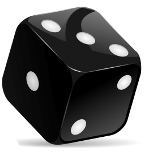Fractions To Decimals

This cake has 10 slices. One slice is one-tenth or 1⁄10 of the cake. Two slices are two-tenths or 2⁄10 of the cake.
To change common fractions to decimal fractions, divide the numerator (on the top) by the denominator (on the bottom).
Terminating Decimals to Learn
| COMMON FRACTION | DECIMAL FRACTION |
| 1⁄10 | 0.1 |
| 2⁄10 = 2⁄5 | 0.2 |
| 3⁄10 | 0.3 |
| 4⁄10 = 2⁄5 | 0.4 |
| 5⁄10 = 1⁄2 | 0.5 |
| 6⁄10 = 3⁄5 | 0.6 |
| 7⁄10 | 0.7 |
| 8⁄10 = 4⁄5 | 0.8 |
| 9⁄10 | 0.9 |
| 1⁄4 | 0.25 |
| 3⁄4 | 0.75 |
| 1⁄8 | 0.125 |
| 3⁄8 | 0.375 |
| 5⁄8 | 0.625 |
| 7⁄8 | 0.875 |
Recurring Decimals to Learn
| COMMON FRACTION | DECIMAL FRACTION |
| 1⁄3 | 0.3 |
| 2⁄3 | 0.6 |
| 1⁄6 | 0.16 |
| 1⁄9 | 0.1 |
| 1⁄11 | 0.09 |
Questions
Use a calculator to change these common fractions to decimal fractions.
Divide the top number by the bottom number.
Round each answer to two decimal places.
Q1. 3⁄7
Q2. 4⁄23
Q3. 5⁄13
Q4. 6⁄7
Q5. 7⁄13
Answers
A1. 0.43
A2. 0.17
A3. 0.38
A4. 0.86
A5. 0.54
Maths Fun - Recurring Decimals
1⁄7 = 0.142857 142857 142857...
1⁄17 = 0.0588235294117647 0588235294117647 0588235294117647 ...
1⁄27 = 0.037 037 037...
1⁄37 = 0.027 027 027...
Use a computer calculator to find the repeating part in these decimals: 1⁄9, 2⁄9, 3⁄9, 4⁄9, 5⁄9, 6⁄9, 7⁄9, 8⁄9, 1⁄11, 2⁄11, 3⁄11 and so on. What do you notice?

| 
| 
|